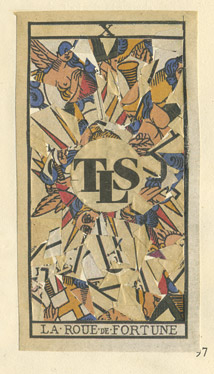A Humbert Party by Carole Richmond
An invitation to write about Humbert is an invitation to the perpetual party that seemingly goes on in Tom’s head. I imagine a mind library full to the brim with encyclopedias, art books, back issues of the TLS (with those that mention Tom on top of the pile), music scores, postcards (fewer now than there used to be) poetry in all its incarnations and a classic literary canon of the old (grammar)school primed and ready to shoot from the hip in defiance of modish thinking. In another room, for in Tom’s mind-house there are many, the images choose to live separate from the words, swirling around cut free from their moorings ready to insert themselves into a piece of text to change the meaning. The room full of tools bristles with brushes, is sticky with paint and glue and occasionally glistens when the edge of a scalpel meets an insight.
In his introduction to Humbert Tom talks of discovering Humbert Wolfe’s Cursory Rhymes, twelve volumes of which have been sacrificed to incessant creativity. On examination he found that this “posh poetry book”, published in 1927, offered a different inspiration to that found in W.H. Mallock’s A Human Document that Tom alchemically transmuted over fifty years into A Humument. It was the spaces left by Wolfe that first attracted Tom and he created various themed notebooks (inevitably embellished with exquisite sketches) attempting to document his life as if it were an illuminated spreadsheet. Volumes dedicated to cricket, worker’s cafes, money, travel, collage and the gingko tree in his garden soon merged one with another as the glorious runaway complexity of Tom’s practice held sway. Lockdown came and Tom, treating the forced insularity as a gift for a poetic adventure, took the chance to condense the notebooks and create a meta-Humbert.
An illuminated book of Tom’s hours, Humbert is dense with idea, image and incidental gossip from the life of an artist, musician, writer, poet and curator. Like A Humument it also contains prophecy of a kind. I was examining the book (with a magnifying glass as Tom helpfully suggest in the introduction) on August 12 when Salman Rushdie was attacked in New York. And I had just found, in miniscule writing and vertical on a page collaged with a newspaper cutting asking “how has the world allowed the murderous edict against you to continue year after year?” a diary entry that calmly stated “Hedged about with secrecy and security men Salman R. comes to play table tennis in the studio”. The page opposite is collaged with a piece of packaging from a Findus Lean Cuisine Salmon Rosti and an excision from the Humbert Wolf poem that was once the sole occupant of the page “art gave heart to the menace of death”.
A few pages on, via references to John Cage’s death, a cleaning lady’s resignation, Yayoi Kasuma, Charles Dickens, a trip to Glyndebourne and a council meeting with “Peter Blake and Liz Frink on my right”, there is another instance of premonition. An image of Donald Trump falls from the bottom of the page accompanied by words “virus the great” excised from A Human Document, the refrain “They have made a wasteland and call it peace” (courtesy of Tactitus) is inscribed repeatedly and a silhouette of a struggling man tumbles from the top of the page towards the capitalised phrase “PLAGUE TORY” and the exhortation “give up Prime Minister, conduct awk-xtreme”.
A visitor to the Humbert party is more likely to encounter artists, writers, other people called Humbert (Nabokov’s monster tap dances with a young girl in Tom’s idea for a Lolita cover and the dashing French tennis player Ugo Humbert has his progress noted on a number of pages), poets, prophets and comic book characters, then there are the woeful politics of our time. The image heavy pages tell a deeper story and hold the eye and concentration, but the gossipy bits are worth the application of a magnifying glass. In my short acquaintance with Humbert I have been propelled down many cultural cul de sacs searching for the key to this particular parade of a life lived in artistic endeavour and self examination. Humbert is mostly about Tom and his work but in his infinite generosity he gives room for other artists to invite you to other parties in different minds.




